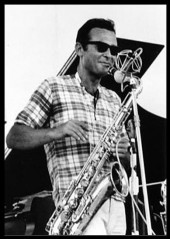Stan Getz
Location:
IT GETZ NO BETTA, US
Type:
Artist / Band / Musician
Label:
Verve/Universal & others
Courtesy of Mr. GER BROUWER
Click here G.N.B.
to see more of Mr. Brouwer's work!
Please come join us!
Visit Stan Getz Community
Stan Getz Interview on NPR with Terry Gross. 1990
"Mickey One" 1965
NEW from GREG FISHMAN! Great tool for beginners and teachers:
Click here to visit Greg Fishman Jazz Studio!
"AN EVENING IN PRAGUE"
HILDE HEFTE AND THE CITY OF PRAGUE PHILHARMONIC ORCHESTRA
TO BE RELEASED NOVEMBER 5th! Click above on Hilde's photo to visit her page for further details and to hear a sampling of this CD. and MORE!
Recording of An Evening In PragueUploaded by hildehefte
“My life is music, and in some vague, mysterious and subconscious way, I have always been driven by a taut inner spring which has propelled me to almost compulsively reach for perfection in music, often—in fact, mostly—at the expense of everything else in my life.” ~Stan Getz
Artists like to improve on nature. The great landscape painters took run of the mill scenes and turned them into works of art. By employing evocative language poets can make their readers yearn so much for the Elyesian fields of their imagination that it hurts.
In his sixth symphony, Beethoven took an ordinary country brook and turned it into a stream that could easily bubble through the Garden of Eden. On a less exalted level, great jazz musicians take ordinary tunes and turn them into great art.
Through the years there have been many, many examples of this, right from the days when King Oliver played West End Blues and Bix Beiderbecke turned I'm Coming Virginia into a small, perfectly formed tone poem.
One of the great transformers of the ordinary was Stan Getz (1927-1991). Getz first made his name in the forties with Woody Herman's Second Herd. One of the most famous numbers he recorded with the band was the Ralph Burns tune Early Autumn.
As well as being a beautiful song, the number demonstrates Getz's masterly way with a melody. First there is the immaculate saxophone tone; like an alto flute; pure and mellow. Getz treats the melody by adding subtle touches here and there; it is masterly. Like when a painter adds a touch of white to the corner of a painted eye.
Getz had an amazing technique, he could play anything on the saxophone. On the album Stan Getz Quartets, Getz recorded a tune called 'Crazy Chords'. In the recording Getz roars through some extreme key changes touching signatures no average sax player in his or her right mind would chose to play. Yet Getz makes it sound like he was taking a stroll by a brook.
On the same album as 'Crazy Chords' there's a fine example of the way Getz treats a slow ballad. 'What's New' is one of the great songs. Played straight it is beautiful, but Getz with a stroke of the brush here and there transforms the melody into a work of art. Like a Rembrant in sound.
Until 1958 Getz played some of the best jazz in the United States and with some of the best jazzmen in the country: Al Haig, Oscar Peterson, Bill Evans, Chet Baker, Jimmy Raney and Horace Silver.
In 1958 he moved to Europe and worked mainly with European musicians like the wonderful Swedish baritone player Lars Gullin, pianist Martial Solal and Bengt Hallberg and with other US ex-patriots like Oscar Pettiford and Kenny Clarke.
In 1961 Getz returned to New York to record what is undoubtedly the best example of a partnership between a jazz musician and strings - the album Focus. Focus is a superb achievement. Getz sails above and around the composer Eddie Sauter's brilliant string arrangements. It's an example of a stunning musician at the height of his considerable powers.
The album Getz made after Focus was Jazz Samba. This contained his greatest hit the Samba, 'Desafinado'. Again 'Desafinado' is a simple tune that Getz turns into high art. After 'Desafinado' Getz's career took a giant step forward. Bossa Nova became a craze for a while and Getz was one of its chief exponents. But it did not reduce his commitment to improve on nature. ~ Written by Colin Frame ~
"All you can do is play melody. No matter how complicated it gets, it’s still a melody.” ~Stan Getz~
Al Haig, Stan, Tommy Potter - Birdland 1949
Photo by Herman Leonard
“There are four qualities essential to a great jazzman. They are taste, courage, individuality, and irreverence. These are the qualities I want to retain in my music.” ~Stan Getz~
Stan & granddaughter Katie
This is PRICELESS! Stan & Shorty Rogers w/Woody Herman Big Band.
Caerulia
DJGETZ
Nick
Pamela
Bev
Dave
Getz
Steve
Getz
Mona
Christina
Copyright © BANDMINE // All Right Reserved
